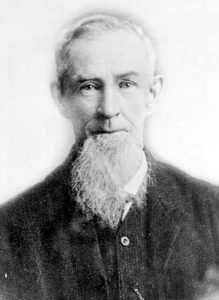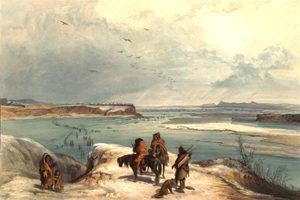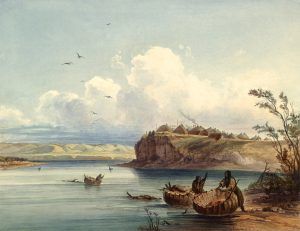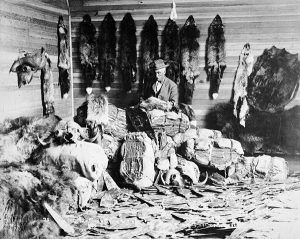A fur trader, James Kipp VI was born on March 15, 1788, near Montreal, Canada, to Samuel Kipp V and Mary Knapp Kipp. Little is known of his early years, but by the time he was 20, he had entered the fur trade in the Red River region, probably working for the North West Company. He was described as standing six feet two inches tall, with blue eyes and brown hair, and having an imposing physique.
In 1813 he returned to Canada, where he married Elizabeth Rocheleau in Kingston on June 23, 1813. The couple then went to Montreal, where James worked as a carpenter, joiner, and mason. They would have two daughters.
By 1818 he was working in the Upper Missouri River region, this time for the Columbia Fur Company. While he was gone, his wife Elizabeth died on October 15, 1818.
In 1822, Kipp was named as the agent at Fort Clark, North Dakota, and primarily traded with the Mandan Indians. He would live there for the next 13 years. He was the first white man to learn and speak their language fluently. In about 1824, he married a Mandan princess, and the couple would have one son, Samuel Kipp, who would also grow up to be a fur trader, as well as a scout. During his time at Fort Clark, he built the White Earth River Fort in Canada in 1825 and Fort Piegan, Montana in the Blackfeet country in 1831.
In the meantime, the Columbia Fur Company was absorbed by the American Fur Company in 1827, and James Kipp continued in their employ. In 1832, George Catlin, an American painter and author of works on the customs and costumes of the Native Americans, came to visit Fort Clark and lived with James Kipp. Of this visit, Kipp would say:
“In the summer of 1832, Mr. George Catlin was a guest in my fort at the Mandan village, observing and learning the customs of the interesting and peculiar people, and painting the portraits of their celebrated men, of which he had many and with great exactness.”
The next year, the German Prince, Alexander Philippe Maximilian of Wied-Neuwied, made a stop at Fort Clark in the course of a study trip across the American “Far West.”
James Kipp left Fort Clark in about 1835 and was dispatched to the upper Missouri River to work among the Blackfeet Indians in Montana. There he built Fort McKenzie. In 1839, at the age of 51, he married a 25-year-old white woman in Missouri named Mary Bloodgood.
In the fall, Kipp usually led a pack train some 2,000 miles up the Missouri River, carrying European and American goods to trade with the Native people of the Upper Missouri River. In the spring, he would lead trips down the Missouri River to St. Louis with a fleet of keelboats or Mackinaws loaded with furs. He continued this pattern well into his 60s.
In 1843 he was in charge of Fort Alexander on the Yellowstone River in Canada.
In July 1844, he purchased land in Platte County, Missouri, where he established a farm and organized expeditions. By the next year, he was once again in the field, having taken charge of Fort Union, North Dakota.
Though he was already married to a white woman back in Missouri, Kipp married another Mandan Indian, Earth Woman, in about 1847. With her, he would have a son named Joseph in 1849.
Along with thousands of others, he joined the California Goldrush in 1849, but he evidently didn’t fare well, as he was soon back working the fur trade on the Missouri River. By the summer of 1851, he was in charge of Fort Berthold, North Dakota, once again trading with the Mandan Indians. Here, he received a young Swiss naturalist painter named Rudolph Friederich Kurz. The painter described Kipp:
“James Kipp was the first man to pilot a steamboat on the Missouri River, around 1840, and he was very familiar with this watercourse due to having navigated it for many years, for which he was called Captain Kipp. In June of each year, at the flooding of the waters of the Missouri River, Captain Kipp descended with his boats filled with furs from the upper regions to Saint Louis to sell them. He sometimes traveled with as many as twenty or thirty boats, and even more, each carrying a load of five tons.”
James Kipp continued to work in the fur trade business along the Missouri River until 1859, when at the age of 71, he retired to his farm in Platte County, Missouri. The next year’s census records showed living in the residence were James and Mary Kipp, Kipp’s son by his first Mandan wife, Samuel, Samuel’s wife, Mariah, and their two children living on the farm.
Kipp continued to make regular visits up the Missouri River to visit his Mandan wife, Earth Woman, his son, Joseph, and his old friends on the Upper Missouri River.
Finally, age caught up with the old trader, and in 1878, when he could no longer travel, he wrote to his son Joseph, “Give my love to your mother and all the family. I remain affectionately, Father.”
James Kipp died on July 2, 1880, at the age of 92. He was buried at Parkville, Missouri.
© Kathy Alexander/Legends of America, updated November 2022.
Also See:
Trading Posts of the Mountain Men
Trappers, Traders & Pathfinders
Sources:




